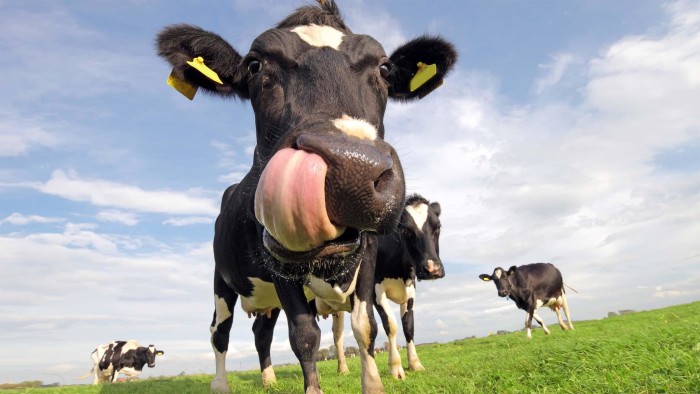Scientists seek climate-friendly cow of the future

Simply sign up to the US & Canadian companies myFT Digest -- delivered directly to your inbox.
A White House climate initiative has boosted a quixotic search for the “cow of the future”, a next-generation creature whose greenhouse gas emissions would be cut by anti-methane pills, burp scanners and gas backpacks.
Carbon dioxide from fossil fuels is the primary man-made gas warming the planet, but methane is far more potent and the US’s biggest source of it is its 88m cattle, which produce more than landfill sites, natural gas leaks or hydraulic fracturing.
The Obama administration’s launch last month of a plan to curb methane emissions has given fresh relevance to climate-friendly technologies for cattle that range from dietary supplements and DNA gut tests to strap-on gas tanks.
Juan Tricarico, director of the Cow of the Future project at the Innovation Center for US Dairy, an Illinois research institute, said the initiative had boosted his quest to create the “star athlete” of the bovine world.
“For us it is very encouraging because it basically demonstrates that important players out there are thinking in similar ways to us,” he told the Financial Times.
But he said there were common misconceptions about where cattle methane comes from. “Ninety-seven per cent of all the methane gas is released by the front end through burps, not from the back end,” he said.
Based on his research priorities, the dairy cow of the future will be the unstressed inhabitant of spacious accommodation, munching on anti-methane gourmet grains that are processed by an efficient, best-in-species digestive system.
“We want it to be more productive, we want it to be healthier, we want it to be a problem-free cow,” said Mr Tricarico.
Methane accounts for 9 per cent of US greenhouse gas emissions and does not linger in the air as long as CO2, but it has a global warming effect more than 20 times greater than CO2, the White House says.
However, financial barriers are hampering the adoption of tools to limit methane from cattle, as was the case with early technology to curb pollution from power stations and motor vehicles.
The costs are prohibitive for dairy and beef farmers and the kind of research that could make the tools more cost-effective would require public funding.
C-Lock, a South Dakota company, sells a feeding station that gives animals dietary supplements such as basil to cut methane production and measures the content of their breath by pulling it towards trace gas sensors with a vacuum.
Patrick Zimmerman, C-Lock’s founder, says prices start at $45,000 but stresses the economic benefits of improved efficiency. “Of the energy the animals eat, 3 to 15 per cent is lost as methane and that’s a waste,” he says.
At Argentina’s National Institute of Agricultural Technology, scientists have created backpacks that collect gas via tubes plugged into cows’ stomachs. A typical animal emits 250-300 litres of methane a day and researchers say this could be used to power a car or a refrigerator for a day, but Jorge Antonio Hilbert of the institute says the tanks’ use on a large scale is “totally improbable”.
Jonathan Gelbard of the Natural Resources Defense Council, an environmental group, says: “Anyone who can come up with a cost-effective way to harness that methane is going to make a lot of money.”
Ilmi Granoff of the Overseas Development Institute said an alternative to controlling cattle emissions would be to cut the number of cows.
“Forget coal, Forget cars. The fastest way to address climate change would be to dramatically reduce the amount of meat people eat,” he said. “But that involves cultural preferences and they are difficult to touch.”
Comments